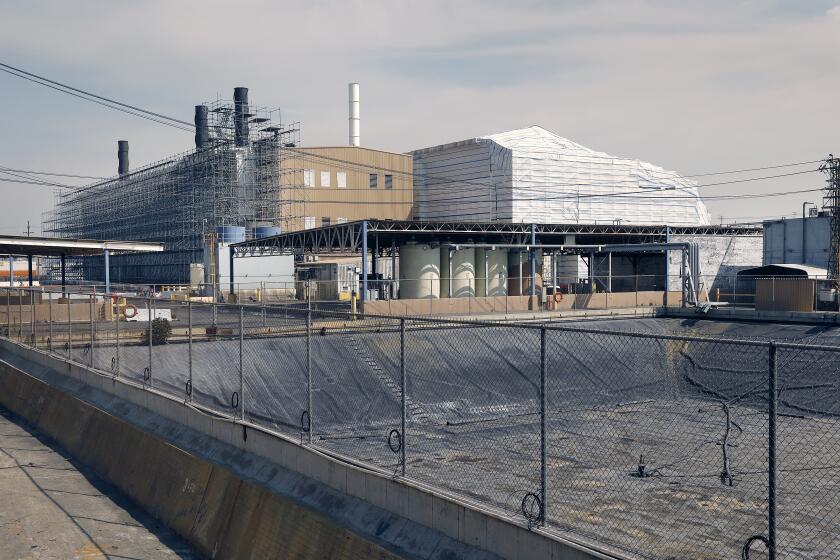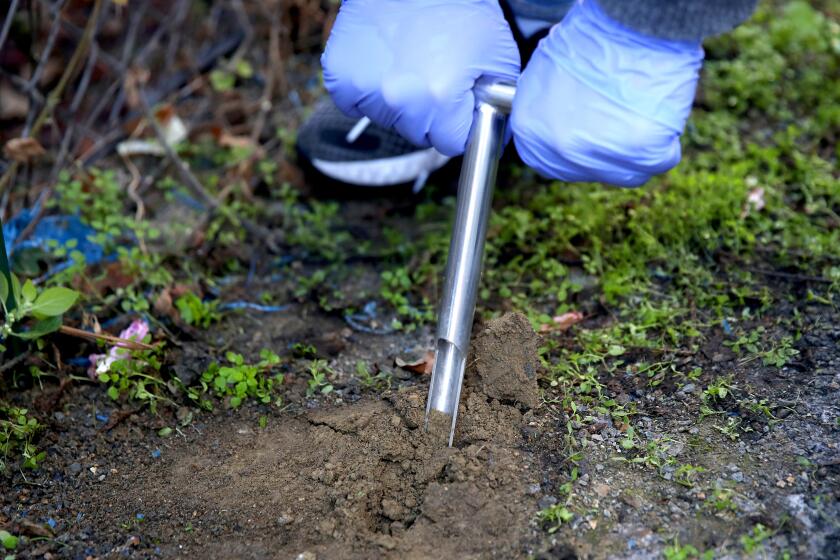
A battery recycling plant in southeast Los Angeles County is one step closer to becoming a Superfund site after the U.S. Environmental Protection Agency determined it contains enough hazardous waste to qualify and California officials welcomed federal assistance.
For nearly a century, the former Exide Technologies plant in Vernon melted down lead-acid car batteries, leaving as many as 10,000 properties coated in brain-damaging lead dust, according to state environmental regulators.
Aggressive and impactful reporting on climate change, the environment, health and science.
Since the facility declared bankruptcy, California has dedicated $750 million and overseen the cleanup of more than 5,000 lead-contaminated properties surrounding the Exide site. But, over the last two years, a coalition of federal and state lawmakers, including U.S. Sens. Alex Padilla and the late Dianne Feinstein, have called for a Superfund designation in hopes that it might bring in federal funding that could help expedite the cleanup or potentially expand its scope.
An EPA report published last week concluded that the Exide site and surrounding communities meet the criteria to be a Superfund site — not for lead, but due to the presence of another toxic chemical.
The Exide facility also released trichloroethylene (TCE) — a known human carcinogen — into the soil, according to the EPA report. For decades, the highly mobile chemical has migrated deeper into the groundwater table and into local aquifers tapped for drinking water.
The Exide facility stands on the brink of Superfund status as Yana Garcia, secretary of the California Environmental Protection Agency, sent a letter to the federal EPA expressing support for a Superfund declaration on behalf of Gov. Gavin Newsom’s administration.
As many as 10,000 properties within 1.7 miles of a shuttered battery recycling plant may have been contaminated. Check your property’s cleanup status.
Exide is one of several industrial facilities that have contributed to extensive groundwater contamination in southeast L.A. County, which has levels of TCE above federally established health limits at several drinking water wells. Although Exide’s groundwater monitoring had shown elevated TCE levels since the 1980s, there had been no action to remove or contain the chemical plume until recently.
“While California has been cleaning up the area for many years, impacts from the operations continue to negatively affect public health,” Garcia said in the letter. “Listing the former Exide facility and surrounding areas would bring critical federal resources and expertise to help address toxic levels of lead where Californians work, live, and play.”
Exide stored TCE in a large open vat and used the chemical as a cooling agent to shape molten metal into bars. Historically, TCE was released near the southern portion of Exide’s Vernon complex. It has seeped into the Exposition aquifer and is believed to be migrating southwest.
Environmental advocates fear that the contamination will seep deeper and affect interconnected aquifers.
The Biden administration announced $179 million for wastewater recycling projects, boosting plans to build the nation’s largest plant in Southern California.
At least 52 groundwater wells serving 300,000 people are within four miles of the Exide site. Several groundwater wells have TCE levels higher than federal drinking water quality limits. The highest readings have been found at a well, near Converse and Gage avenues in unincorporated Florence-Firestone, where water contained 140 micrograms of TCE per liter — 28 times higher than federal drinking water limit.
This has forced water providers, including Golden State Water Co., to dilute contaminated groundwater with surface water or install expensive water treatment systems to remove TCE.
“Our customers don’t have to think twice about the quality of drinking water coming from their taps,” said Dawn White, a water quality manager with Golden State Water Co. “While the EPA report was not shared with Golden State Water, it is common for TCE or other contaminants to be found in water sources throughout California. When they are detected, water is treated to meet federal and state water drinking standards before being delivered to customers.”
In shallow groundwater, TCE can reemerge as a vapor. The EPA report found vapors on the Exide grounds, although the building hasn’t been occupied since 2014. Two nearby sites may also be responsible for their own TCE plumes.
Numerous homes that underwent remediation have been left with lead concentrations in excess of state health standards, according to USC researchers.
Although water contamination was the basis for the EPA’s Superfund qualification, environmental advocates say they still want federal money to go toward removing lead contamination. Testing by USC has shown high levels of lead contamination beyond the 1.7-mile Exide cleanup zone that the state is working on.
“It’s clear there are major issues with groundwater that must be addressed,” said Jane Williams, executive director of California Communities Against Toxics. “But the soil contamination clearly extends outside the preliminary assessment area, and someone needs to go look there. We cannot abandon those people.”
Toward a more sustainable California
Get Boiling Point, our newsletter exploring climate change, energy and the environment, and become part of the conversation — and the solution.
You may occasionally receive promotional content from the Los Angeles Times.
Padilla said in a statement that he has asked the EPA to move forward with the Superfund designation and a “long overdue cleanup.”
“The completion of the inspection report is a step in the right direction in achieving justice for the Southeast L.A. communities that have suffered the devastating consequences of Exide Technologies illegally dumping lead and other hazardous contaminants into the ground and water supply,” he said.
An organizer with East Yard Communities for Environmental Justice, mark! Lopez, said the EPA should fund the cleanup of rail yards, which have not been cleaned and may be heavily contaminated with lead.
“The massive rail yards are where the federal government should be coming in because that’s where we’re going to find the highest levels of lead,” Lopez said, noting their proximity to the Exide plant and to homes. “Every time the wind blows, it’s recontaminating our communities. And they have particular authority around rail that the state doesn’t.”
A Supreme Court ruling overturning the so-called Chevron doctrine is likely to pave the way for legal challenges to California’s clean air rules.












